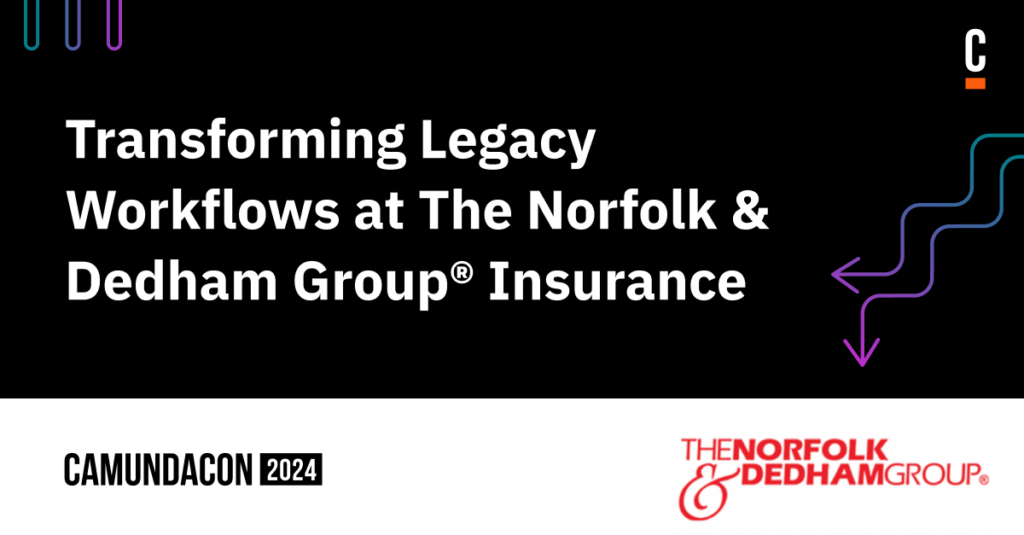At CamundaCon NYC in October 2024, Shashidar Ayachitam, IT Director from The Norfolk & Dedham Group® Insurance, spoke to us about the company’s journey in updating its legacy workflow tools.
In his presentation, he discussed how embracing a modern process orchestration and automation tool like Camunda can lead to remarkable organizational change and set the stage for future growth. Sashi shares their transformative journey from an outdated BPM tool to a Camunda-centered architecture, enhancing its claims processes and customer interactions with increased efficiency, visibility, compliance, and customization, all while delivering the exceptional customer service that customers now expect as standard.
CamundaCon allows fellow industry professionals and thought leaders to exchange practical insights and tactics, discover helpful hints and techniques, and participate in workshops, lectures, and process orchestration and automation events throughout the conference. If you’d like to know more, regardless of your familiarity with the Camunda community or process orchestration and automation, please check out our upcoming local and national events.
The challenge of outdated systems
The Norfolk & Dedham Group® Insurance, boasting a rich history of 200 years, recognized that its old workflow system, established in 2004, was no longer adequate. The company’s legacy platform, responsible for approximately 650 essential workflows, was suddenly left without support when another provider acquired it. As a result, the outdated and unsupported system posed a security threat and hindered the efficiency of the customer experience due to its lack of a viable upgrade option.
Its tightly coupled architecture was now preventing the flexibility needed for the company’s future growth in the competitive, customer-centric, and agile insurance arena.
Legacy and outdated systems can be negative for process automation and orchestration best practices because they can lead to a number of challenges, including but not limited to:
- Decreased productivity: System downtime can lead to lost customers and decreased team member efficiency.
- Expensive maintenance: Outdated systems are more likely to fail, which can make them expensive to fix and maintain, and it is difficult to recruit staff with the knowledge to maintain custom or dated solutions.
- Frequent outages: Outdated software is less likely to be reliable and may break more often.
- Incompatibility: When older systems are combined with newer ones, issues such as data inconsistencies, system incompatibilities, and workflow disruptions can arise, leading to inefficiencies and potential downtime. Outdated data can cause disruptions and delays in process.
- Compliance: Compliance requirements often require the use of up-to-date and secure software.
- Lack of support: As communities move to newer technologies, support for older ones decreases, increasing the risk of security failure and without a clear upgrade route.
- Stuck in the past: Future-proofing process orchestration is crucial to ensure an organization’s workflows remain agile, scalable, and adaptable to evolving technological advancements and market demands, thereby maintaining operational efficiency and competitive edge over time.
According to Shashi, the need for modernization was clear and critical, and the company required a robust, API-driven, and decoupled orchestration and automation solution to modernize its claims operations, underwriting, and customer support and through which to incorporate helpful emerging technologies like AI.
The Camunda solution
After thorough consideration and proof-of-concept trials, Camunda stood out as the solution of choice due to its maturity, scalability, and flexibility. Adopting a microservices architecture, The Norfolk & Dedham Group® Insurance could ensure seamless interactions and prepare for future technological shifts.
“We built customized components and deployed them quickly. The benefits we are witnessing from these are substantial. The Operate analytics are astounding, providing daily insights that have led to strategic and tactical decisions.”
– Shashi Ayachitam, IT Director, The Norfolk & Dedham Group® Insurance.
Camunda offers decoupled orchestration through its remote workflow engine, which can be provisioned and configured separately from the application and process solution. This decoupling allows for a number of benefits, including:
- Independent scaling: The workflow engine can be scaled without affecting the application code.
- Easier troubleshooting: Issues can be easily identified in one component, and vulnerabilities are not spread to other components.
- Software as a service: The workflow engine can be operated as a service, either in a public cloud or as an in-house service.
- Local application development: Applications can connect remotely to the workflow engine, allowing for local or on-premise development.
Camunda is a process orchestration and automation platform that helps organizations design, automate, and improve processes and business rules. It plays a significant role in decoupling applications and processes in the following ways:
- Process engine abstraction: Camunda provides a process engine that acts as a layer of abstraction between business processes and the applications that perform the tasks within those processes. By defining processes in BPMN (Business Process Model and Notation) and decisions in DMN (Decision Model and Notation), Camunda allows you to change and manage processes without modifying the underlying applications.
- Microservices orchestration: Camunda can orchestrate microservices by sending signals to start or complete tasks. This allows individual microservices to remain loosely coupled and focused on their specific functionality while the Camunda engine manages the state and order of process execution.
- External task pattern: Camunda supports the External Task pattern, where services outside the process engine handle long-running or resource-intensive tasks. These external tasks communicate with the process engine to fetch and complete work items. This decouples task execution from the workflow engine and allows different applications to work on tasks independently.
- Event-driven architecture: With Camunda, you can implement an event-driven architecture that triggers processes in response to events. Applications can publish events without being aware of the internal details of the processes they activate, thus decoupling the event producers from the process consumers.
- REST API and message queues: Camunda provides REST APIs and can integrate with message queues (like AMQP, Kafka, etc.), allowing applications to interact with the process engine without being directly linked. Applications can push and pull information from the process engine as needed, decoupling them from each other and the engine itself.
- Versioning and deployment: Camunda allows for versioning of process definitions. This means that new versions of a process can be deployed without affecting running instances of older versions. Applications can continue to operate with the process version they were designed for, providing a clear upgrade path without tightly coupling the application lifecycle to the process lifecycle.
By leveraging these features, Camunda enables organizations to maintain a clear separation between their business processes and the applications that support them, facilitating easier maintenance, scalability, and adaptability to change.
The results are in
In his presentation, Shashi discusses how the implementation of Camunda brought immediate and significant improvements:
- Processing time: Claim processing time was reduced by 35%, enhancing operational efficiency.
- Cost savings: Costs per claim lowered by 30%, contributing to financial health.
- Scalability: The solution facilitated expansion into new business areas and adaptability for further growth.
“We cut down 35% of the time in processing the claims and reduced 30% cost per claim since we went live with Camunda.”
– Shashi Ayachitam, IT Director, The Norfolk & Dedham Group® Insurance.
Strategic partnerships cement success
To aid in development and implementation, The Norfolk & Dedham Group® Insurance engaged with Camunda Platinum Partner NTConsult. Their expertise was invaluable to the successful transition. Shashi cites Camunda and NTConsult’s unwavering support as an invaluable part of the development and implementation process.
“There won’t be any disappointment [with Camunda]. We like it and will continue using Camunda and have NTConsult as our strategic partners for a long time.”
– Shashi Ayachitam, IT Director, The Norfolk & Dedham Group® Insurance.
Streamlined processes have led to quicker resolutions, improved customer satisfaction, and provided a wealth of actionable insights, enabling better decision-making and IT efficiency. The Norfolk & Dedham Group® Insurance plans to extend Camunda’s functionalities to underwriting and customer support. Additionally, they are exploring the integration of AI to enhance process automation further.
We also spoke to Shashi behind the scenes at CamundaCon NYC ‘24, where he candidly discussed their experience and the positive changes that implementing Camunda has afforded his team.
The presentation by Shashi Ayachitam illustrates the transformative power of Camunda’s process orchestration and automation capabilities, something we’re proud to bring to thousands of companies around the world (and even in space). This strategic move has not only resolved current operational challenges for The Norfolk & Dedham Group® Insurance but has also opened doors to new possibilities, ensuring the company remains agile and competitive in the ever-evolving and fiercely competitive insurance market.
Learn more
To learn more about the journey of The Norfolk & Dedham Group® Insurance, you can read their full case study here.




Start the discussion at forum.camunda.io